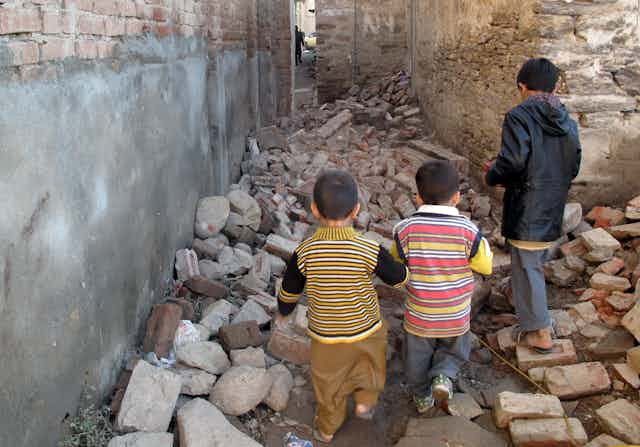As relief workers and public officials struggle to assess the damage from the 7.5 magnitude earthquake that struck Afghanistan’s north-eastern Hindu Kush region, many of us are calling to mind the devastating Kashmir earthquake of 2005 and asking how the people of Afghanistan and Pakistan will cope with this event.
At least 339 people have been reported dead, with thousands injured. This loss is as tragic as it is incomprehensible, especially since estimates suggest a loss of up to 1,000 lives before the count is finished. Yet the world of disaster management has come a long way since the 2005 earthquake, leaving Pakistan with some cause for optimism.

Defining disaster
Before we go any further, let’s define what a disaster is. A disaster is a societal disruption spurred by a critical event. The critical event is the earthquake, the tsunami, the typhoon. The disaster is the resultant effect on humanity, which is often measured in lives lost, homes damaged, and money spent to rebuild.
This definition means that a critical event does not automatically cause a disaster. In 1998, for example, a 8.1 magnitude earthquake struck the Balleny Islands region of Antarctica. One of the strongest earthquakes in history, few have heard of it because no disaster ensued.
The definition also means that some disasters are avoidable. Coordinating efforts across levels of government and agencies worldwide help target resources to the neediest places. Building infrastructure with attention to the probability of critical events helps minimise physical damage, which also keeps people safe. Research has shown that managing disasters well increases public trust in officials, which then increases the likelihood citizens will follow disaster plans in the future.
The Kashmir earthquake in 2005 killed at least 86,000 people and injured close to 70,000 more. It was a catastrophe that wiped out not just villages and small towns, but also all nearby resources those villages might have called upon for help.
One remarkable consequence of the devastation surrounding this earthquake and others of that time was a renovation of disaster plans throughout the region. Afghanistan and Pakistan will benefit from these changes today.
Building back better
Prior to 2005, disaster efforts were largely reactive – rescue people, deliver water, administer medications. While the mantra in 2005 may have been “rebuild quickly”, the mantra today is “build back better”, meaning public officials have tried to learn from previous events and implement infrastructure strengthening mechanisms during the recovery process.
This new focus will help Afghanistan and Pakistan recover now. The Sendai Framework for Disaster Risk Reduction, endorsed by the UN General Assembly in March of this year, is a commitment among nations to coordinate international efforts.
It builds on the Hyogo Framework for Action, under which the previous ten years were spent strengthening communication networks and promoting disaster resilience and risk reduction.

Social media
The rise of social media has drastically improved things for disaster workers in countries like Afghanistan and Pakistan. Consider Humanitarian Open Street Map, an open-source map-making database built by users around the world and endorsed by the World Bank. Concerned observers from any part of the world can now scour satellite images and contribute to pre and post-event maps, helping rescue workers assess damage and target their efforts effectively.
Citizens in unaffected regions, previously unable to participate in relief efforts, are now helping manage and prepare for disasters across the globe. The World Bank’s Global Facility for Disaster Reduction and Recovery capitalises on the energy and charity of the crowd as volunteers offer virtual time and intellect.
Not all earthquakes are equal
In addition to international coordination among relief agencies and volunteers, we should be mindful of the geological specifics of Afghanistan’s earthquake. The 2005 earthquake was a magnitude 7.6, about 1.26 times bigger than the magnitude 7.5 earthquake in Afghanistan.
The difference in magnitude corresponds to a difference in strength as well; the 2005 quake released 1.41 times the amount of energy as this week’s earthquake did (you can use the US Geological Survey’s calculator to compute the differences yourself).

The latest earthquake occurred approximately 210km below the surface of the earth, which seismologists consider the “intermediate depth” for earthquakes. Earthquakes at this depth generate shaking a great distance from their epicentres, but generally cause less damage on the surface than earthquakes of equal magnitude with shallower depth. The Kashmir earthquake was one such shallow earthquake, occurring a mere 26km below the surface.
These differences are meaningful. Though the earthquake was felt as far away as India’s capital city of New Delhi, its relative depth, magnitude, and strength will make it much less devastating than the shallower, more intense, stronger quake of 2005.
Recent events in the Hindu Kush region have definitely caused a great amount of death and damage. There is no doubt that a disaster is occurring. By final count the social and economic losses will be measured at individual, community, and national levels.
But the past ten years of dedication to disaster preparedness and recovery planning will put the people of Afghanistan and Pakistan in a position to better recover, rebuild, and plan for the future.

